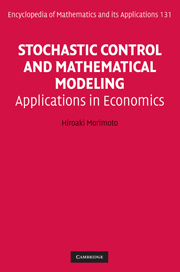Book contents
- Frontmatter
- Contents
- Preface
- Part I Stochastic Calculus and Optimal Control Theory
- Part II Applications to Mathematical Models in Economics
- 6 Production Planning and Inventory
- 7 Optimal Consumption/Investment Models
- 8 Optimal Exploitation of Renewable Resources
- 9 Optimal Consumption Models in Economic Growth
- 10 Optimal Pollution Control with Long-Run Average Criteria
- 11 Optimal Stopping Problems
- 12 Investment and Exit Decisions
- Part III Appendices
- Bibliography
- Index
8 - Optimal Exploitation of Renewable Resources
from Part II - Applications to Mathematical Models in Economics
Published online by Cambridge University Press: 07 September 2011
- Frontmatter
- Contents
- Preface
- Part I Stochastic Calculus and Optimal Control Theory
- Part II Applications to Mathematical Models in Economics
- 6 Production Planning and Inventory
- 7 Optimal Consumption/Investment Models
- 8 Optimal Exploitation of Renewable Resources
- 9 Optimal Consumption Models in Economic Growth
- 10 Optimal Pollution Control with Long-Run Average Criteria
- 11 Optimal Stopping Problems
- 12 Investment and Exit Decisions
- Part III Appendices
- Bibliography
- Index
Summary
We study the stochastic optimization problem of renewable resources. We consider planning authorities who want to determine the amount of harvest from publicly owned resources.
The authorities expoit at the rate c(t) from the stock of resource until the resource is totally exhaused. The stock X(t) is renewable if some positive level of stock X(t) can be maintaines by the rate of increase f(X(t)) of this stock indefinitely. The growth rate of stock X(t) coincides with the totality of f(X(t)) and the white noise process dB(t)/dt, which is interpreted as the uncertain fluctuation of the resource, when there is no exploitation of the stock. The natural resource allows us to exploit if its position remains to be nonnegative. The authorities' aim is to maximize the expected discounted utility of exploitation with a utility function U(c).
We analyze the associated HJB equation (8.7) and further show the C2-regularity of the viscosity solution. We present the existence of an optimal policy in a feedback form or a stochastic version of Hotelling's rule.
The Model
Consider a mathematical problem of the renewable natural resource with uncertainty. Define the following quantities:
X(t) = remaining stock of the renewable resource at time t.
f(X(t))) = rate of renewable change of the stock at time t.
c(t) = flow of exploitation (or consumption) at time t.
B(t) = the standard Brownian motion.
[…]
- Type
- Chapter
- Information
- Stochastic Control and Mathematical ModelingApplications in Economics, pp. 197 - 216Publisher: Cambridge University PressPrint publication year: 2010



